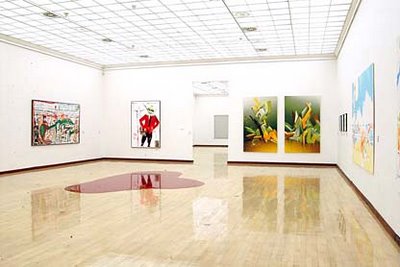What would I be without you ... German Art Last Forty Years
4.7 bis 22.10 2006
Our exhibition shows the artistic strategies and describes the development of painting in Germany in the last forty years. The period begins in the sixties as it was sixties that saw developments that shaped the artistic environment of Germany. One of the most important centres during this period was the Academy in Düsseldorf. Of the professors, Joseph Beuys was particularly active and contributed greatly to the revival and further development of fine art in Germany. It was him and Karl Otto Götz, a painter of the informell school, also teaching at the Academy, who had a very positive impact on young artists. Joseph Beuys endeavour to bring artistic creativity to all spheres of life, led to political events in the seventies.

Because of his artistic as well as his public engagement Beuys enjoyed considerable influence. Many of the now renowned artists included in the exhibition are former students of the Düsseldorf Academy: Sigmar Polke, Gerhard Richter, Franz Erhard Walther, Kuno Gonschior, Palermo, Jörg Immendorff, Markus Lüpertz, Imi Knoebel, Raimund Girke, Gotthard Graubner and Edgar Hofschen.
Franz Erhard Walther developed his art of working with textile materials as a student at the Düsseldorf Academy. His art is based on the traditional shape of a table and extends as far as the objects of experimental instrumental character. Since 1971, F. E. Walther has been a professor at the University of Fine Art in Hamburg and an influential teacher of many members of the young artistic generation.
Having lived until 1980 in the former Democratic Republic of Germany, in the sixties A. R. Penck came up with a figurative language form consisting of adjusted shapes, graphical strokes and characters, capturing the problematic situations of an individual in the social reality.
Painting on the edge between abstraction and objectivity was the motivation for artists who were already active in Western Berlin. Georg Baselitz’s subjects are placed on a head; the painting reflects the dialectics of the subject and the art of painting. In his neo-expressionistic figurative paintings and painted statues K. H. Hödicke examined the mythology of ordinary life of a city. The theme for Bernd Koberling´s expressive paintings of amorphous forms of nature is the threat to nature, observed in very great detail. Markus Lüpertz created the so-called “dithyrambic painting”. In 1964 together with Koberling and Hödicke, Lüpertz founded the self-help gallery “Großgörschen 35“ in Berlin (Western).
In the early seventies, artists such as Raimund Girke, Edgar Hofschen, Rolf Rose, Gotthard Graubner and Kuno Gonschior, who were inspired by the magical and meditative sound of colours, developed the art of painting that set the very act of painting as the actual theme for painting.
Ongoing changes of painting methods, accompanied by a swift shift in motives, characterize the works of Gerhard Richter. His works symbolize the constant changes in expressing a philosophical assertion, according to which there is a different existence of the painted picture in relation to the model picture and a different existence of the painted picture and the model picture in relation to the perceived reality.
One of the key personalities for the next generation of artists in the eighties is Sigmar Polke, examining various media; he treats photographs according to the painting criteria and, on the contrary, sometimes opts for chemicals for his photographs. In the eighties the feeling of being part of a group again became important to artists. Art was often created as a common piece of work. Martin Kippenberger, Werner Büttner and Albert Oehlen, presented in this exhibition, were part of the wide circle of the so-called “young rebels” (Junge Wilde).
In the late eighties other media such as photography, video art and installation were at the centre of what went on in the world of art. In her knitted images or other objects, Rosemarie Trockel expresses feministic views.
The decisive political and social changes affected and also altered the artistic debate. Following the reunification of Germany, Berlin became a new thriving artistic centre. Jonathan Meese is one of the new Berlin stars. He draws his ideas for paintings from the remote history.
Visual experiences from video art, films and photography are being transformed into a new world of paintings of contemporary painting. New historical paintings by Daniel Richter portray gruesome scenes, in which the respective figures act unrealistically. Neo Rauch’s work balances between realism and abstraction. His paintings are brought to life by a suggestive blending of time.
Till Gerhard in his paintings also reflects events taking place somewhere bordering on a dream and a nightmare. Carsten Nicolai is often regarded as the one crossing the border between music and fine art. Uwe Kowski brings up-to-date abstractive painting. The world of his paintings represents intuitive imagination and ideas.
The exhibition takes place under the auspices of Mr. Vít zslav Jandák, Minister of Culture of the Czech Republic, and Mr. Helmut Elfenkämper, Ambassador of Germany to the Czech Republic.
Künstler:
Georg Baselitz, Joseph Beuys, Norbert Bisky, Werner Büttner, Hanne Darboven, Günther Förg, Till Gerhard, Raimund Girke, Kuno Gonschior, Karl Otto Götz, Gotthard Graubner, Karl Horst Hödicke, Edgar Hofschen, Jörg Immendorff, Martin Kippenberger, Imi Knoebel, Bernd Koberling, Uwe Kowski, Dieter Krieg, Markus Lüpertz, Jonathan Meese, Carsten Nicolai, Albert Oehlen, C. O. Paeffgen, Blinky Palermo, Angelika Platen, A. R. Penck, Sigmar Polke, Neo Rauch, Mirko Reisser (DAIM), Daniel Richter, Gerhard Richter, Rolf Rose, Cornelia Schleime, Rainer Splitt, Norbert Tadeusz, Rosemarie Trockel, Franz Erhard Walther, Heiko Zahlmann
Kurator: Hana Larvova
Städtische Galerie, Prag
Sektion Sammlungen und Ausstellungen
Mariánské Ring 1
110 00 Prag
Tschechische Republik
fon +420-222 311 724
[email protected]
citygalleryprague.cz
Labels: ausstellungen , what-would-i-be-without-you
 nach oben
nach oben

 zurück
zurück

 Feed
Feed